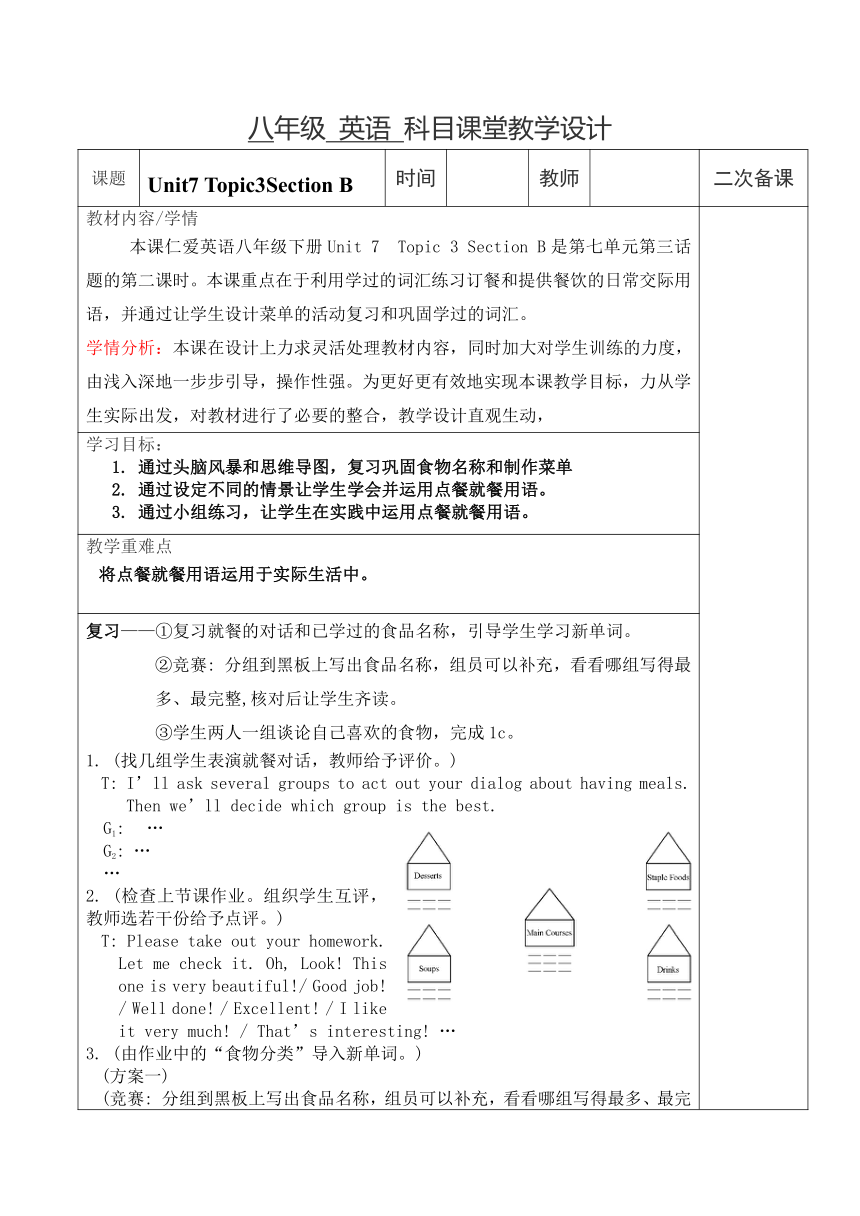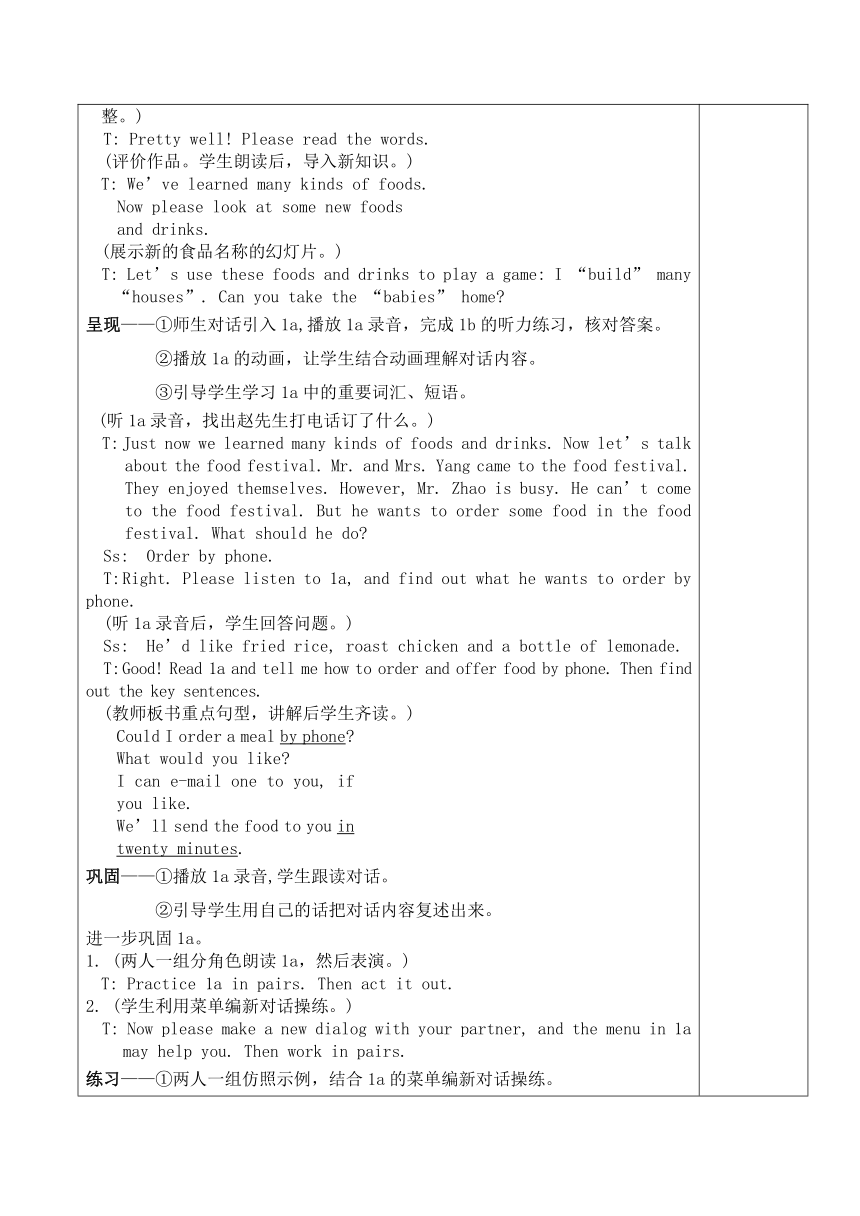Unit 7 Topic3 I Cooked the Most Successfully Section B 教案
文档属性
| 名称 | Unit 7 Topic3 I Cooked the Most Successfully Section B 教案 |  | |
| 格式 | docx | ||
| 文件大小 | 33.6KB | ||
| 资源类型 | 教案 | ||
| 版本资源 | 仁爱科普版 | ||
| 科目 | 英语 | ||
| 更新时间 | 2021-06-01 14:22:58 | ||
图片预览


文档简介
八年级 英语 科目课堂教学设计
课题
Unit7 Topic3Section B
时间
教师
二次备课
教材内容/学情
本课仁爱英语八年级下册Unit 7 Topic 3 Section B是第七单元第三话题的第二课时。本课重点在于利用学过的词汇练习订餐和提供餐饮的日常交际用语,并通过让学生设计菜单的活动复习和巩固学过的词汇。
学情分析:本课在设计上力求灵活处理教材内容,同时加大对学生训练的力度,由浅入深地一步步引导,操作性强。为更好更有效地实现本课教学目标,力从学生实际出发,对教材进行了必要的整合,教学设计直观生动,
学习目标:
1. 通过头脑风暴和思维导图,复习巩固食物名称和制作菜单
2. 通过设定不同的情景让学生学会并运用点餐就餐用语。
3. 通过小组练习,让学生在实践中运用点餐就餐用语。
教学重难点
将点餐就餐用语运用于实际生活中。
复习——①复习就餐的对话和已学过的食品名称,引导学生学习新单词。
②竞赛: 分组到黑板上写出食品名称,组员可以补充,看看哪组写得最 多、最完整,核对后让学生齐读。
③学生两人一组谈论自己喜欢的食物,完成1c。
1. (找几组学生表演就餐对话,教师给予评价。)
T: I’ll ask several groups to act out your dialog about having meals. Then we’ll decide which group is the best.
30181556731000 G1: …
G2: …
…
2. (检查上节课作业。组织学生互评,教师选若干份给予点评。)
T: Please take out your homework. Let me check it. Oh, Look! This one is very beautiful!/ Good job! / Well done! / Excellent! / I like it very much! / That’s interesting! …
3. (由作业中的“食物分类”导入新单词。)
(方案一)
(竞赛: 分组到黑板上写出食品名称,组员可以补充,看看哪组写得最多、最完整。)
T: Pretty well! Please read the words.
(评价作品。学生朗读后,导入新知识。)
T: We’ve learned many kinds of foods.
Now please look at some new foods
and drinks.
(展示新的食品名称的幻灯片。)
T: Let’s use these foods and drinks to play a game: I “build” many “houses”. Can you take the “babies” home?
呈现——①师生对话引入1a,播放1a录音,完成1b的听力练习,核对答案。
②播放1a的动画,让学生结合动画理解对话内容。
③引导学生学习1a中的重要词汇、短语。
(听1a录音,找出赵先生打电话订了什么。)
T: Just now we learned many kinds of foods and drinks. Now let’s talk about the food festival. Mr. and Mrs. Yang came to the food festival. They enjoyed themselves. However, Mr. Zhao is busy. He can’t come to the food festival. But he wants to order some food in the food festival. What should he do?
Ss: Order by phone.
T: Right. Please listen to 1a, and find out what he wants to order by phone.
(听1a录音后,学生回答问题。)
Ss: He’d like fried rice, roast chicken and a bottle of lemonade.
T: Good! Read 1a and tell me how to order and offer food by phone. Then find out the key sentences.
(教师板书重点句型,讲解后学生齐读。)
Could I order a meal by phone?
What would you like?
I can e-mail one to you, if you like.
We’ll send the food to you in twenty minutes.
巩固——①播放1a录音,学生跟读对话。
②引导学生用自己的话把对话内容复述出来。
进一步巩固1a。
1. (两人一组分角色朗读1a,然后表演。)
T: Practice 1a in pairs. Then act it out.
2. (学生利用菜单编新对话操练。)
T: Now please make a new dialog with your partner, and the menu in 1a may help you. Then work in pairs.
练习——①两人一组仿照示例,结合1a的菜单编新对话操练。
练习本课活动1b和2。
1. (4人一组,复习菜单中关于食物和饮料的词汇。然后用同伴最喜欢的食物和饮料完成1b的表格。)
T: Discuss the menu in 1a in groups of four, and then complete the form in 1b with your partners’ favorite food and drinks.
2. (让学生朗读1b的两个例子,并把学生分组,让其根据A中的表格编对话并表演。)
T: Please read the two examples in 1b and learn how to order dishes according to the table in A.
T: Very good! Now let’s learn more about ordering and offering food.
(教师板书重点句型。)
What would you like?
May I have the menu, please?
Just a little, please.
(教师讲解如何运用这些句子,让学生仿照例子,组织对话。完成1b。)
T: Please work in pairs after the examples in 1b, and then act it out in the front.
(学生表演之后,检查效果,并对学生给予充分的肯定。)
3. (采用服务员与顾客对话的形式归纳复习就餐用语。)
T: Well done! Everyone has his favorite food. When you eat out, do you know how to order the food? Let’s ask some students to have a try.
S1: Welcome to our restaurant. This way, please!
S2: Thank you!
S1: May I take your order?
S2: I’d like some fried rice, vegetable soup and fried chicken.
S1: Anything to drink?
S2: Some coke, please.
(A moment later)
S1: Help yourself !
S2: Thanks.
(A moment later)
S2: May I have the bill?
S1: Let me see. It’s¥40.8.
S2: Here you are.
S1: Wait a moment please. Here’s your change. Thanks for coming.
(如有时间可多表演两组,教师给予肯定并评价。)
4. (看2图,设置听力任务。)
T: Look at the picture of 2. Two girls are talking about what food they will prepare for the party. Can you guess what they want to prepare?
Ss: I think they will prepare noodles, ice cream, …
(让学生猜的同时复习听力中可能会出现的食品名称。)
T: Maybe you are right. Now listen to 2. And check your answers.
(播放2录音,归纳总结,核对答案。完成2。)
T: What will they prepare? Can you tell me?
Ss: Yes. They will prepare fried rice, fish curry, …
拓展——让学生制作一份英文菜单,巩固所学食物词汇。
语音——引导学生学习两组元音音素,并注意句子升降调和连读。
检测——通过让学生抢答或齐答的形式完成练习,检测并反馈学生的学习情况。
小结——引导学生归纳本堂课的单词、句型等功能项目,让学生能把握整堂课的重点。
板书设计
作业布置:设计了书面显性作业及课文朗读、对话练习、预习新课等隐性作业。
课后反思:
存在问题:
解决问题:
课题
Unit7 Topic3Section B
时间
教师
二次备课
教材内容/学情
本课仁爱英语八年级下册Unit 7 Topic 3 Section B是第七单元第三话题的第二课时。本课重点在于利用学过的词汇练习订餐和提供餐饮的日常交际用语,并通过让学生设计菜单的活动复习和巩固学过的词汇。
学情分析:本课在设计上力求灵活处理教材内容,同时加大对学生训练的力度,由浅入深地一步步引导,操作性强。为更好更有效地实现本课教学目标,力从学生实际出发,对教材进行了必要的整合,教学设计直观生动,
学习目标:
1. 通过头脑风暴和思维导图,复习巩固食物名称和制作菜单
2. 通过设定不同的情景让学生学会并运用点餐就餐用语。
3. 通过小组练习,让学生在实践中运用点餐就餐用语。
教学重难点
将点餐就餐用语运用于实际生活中。
复习——①复习就餐的对话和已学过的食品名称,引导学生学习新单词。
②竞赛: 分组到黑板上写出食品名称,组员可以补充,看看哪组写得最 多、最完整,核对后让学生齐读。
③学生两人一组谈论自己喜欢的食物,完成1c。
1. (找几组学生表演就餐对话,教师给予评价。)
T: I’ll ask several groups to act out your dialog about having meals. Then we’ll decide which group is the best.
30181556731000 G1: …
G2: …
…
2. (检查上节课作业。组织学生互评,教师选若干份给予点评。)
T: Please take out your homework. Let me check it. Oh, Look! This one is very beautiful!/ Good job! / Well done! / Excellent! / I like it very much! / That’s interesting! …
3. (由作业中的“食物分类”导入新单词。)
(方案一)
(竞赛: 分组到黑板上写出食品名称,组员可以补充,看看哪组写得最多、最完整。)
T: Pretty well! Please read the words.
(评价作品。学生朗读后,导入新知识。)
T: We’ve learned many kinds of foods.
Now please look at some new foods
and drinks.
(展示新的食品名称的幻灯片。)
T: Let’s use these foods and drinks to play a game: I “build” many “houses”. Can you take the “babies” home?
呈现——①师生对话引入1a,播放1a录音,完成1b的听力练习,核对答案。
②播放1a的动画,让学生结合动画理解对话内容。
③引导学生学习1a中的重要词汇、短语。
(听1a录音,找出赵先生打电话订了什么。)
T: Just now we learned many kinds of foods and drinks. Now let’s talk about the food festival. Mr. and Mrs. Yang came to the food festival. They enjoyed themselves. However, Mr. Zhao is busy. He can’t come to the food festival. But he wants to order some food in the food festival. What should he do?
Ss: Order by phone.
T: Right. Please listen to 1a, and find out what he wants to order by phone.
(听1a录音后,学生回答问题。)
Ss: He’d like fried rice, roast chicken and a bottle of lemonade.
T: Good! Read 1a and tell me how to order and offer food by phone. Then find out the key sentences.
(教师板书重点句型,讲解后学生齐读。)
Could I order a meal by phone?
What would you like?
I can e-mail one to you, if you like.
We’ll send the food to you in twenty minutes.
巩固——①播放1a录音,学生跟读对话。
②引导学生用自己的话把对话内容复述出来。
进一步巩固1a。
1. (两人一组分角色朗读1a,然后表演。)
T: Practice 1a in pairs. Then act it out.
2. (学生利用菜单编新对话操练。)
T: Now please make a new dialog with your partner, and the menu in 1a may help you. Then work in pairs.
练习——①两人一组仿照示例,结合1a的菜单编新对话操练。
练习本课活动1b和2。
1. (4人一组,复习菜单中关于食物和饮料的词汇。然后用同伴最喜欢的食物和饮料完成1b的表格。)
T: Discuss the menu in 1a in groups of four, and then complete the form in 1b with your partners’ favorite food and drinks.
2. (让学生朗读1b的两个例子,并把学生分组,让其根据A中的表格编对话并表演。)
T: Please read the two examples in 1b and learn how to order dishes according to the table in A.
T: Very good! Now let’s learn more about ordering and offering food.
(教师板书重点句型。)
What would you like?
May I have the menu, please?
Just a little, please.
(教师讲解如何运用这些句子,让学生仿照例子,组织对话。完成1b。)
T: Please work in pairs after the examples in 1b, and then act it out in the front.
(学生表演之后,检查效果,并对学生给予充分的肯定。)
3. (采用服务员与顾客对话的形式归纳复习就餐用语。)
T: Well done! Everyone has his favorite food. When you eat out, do you know how to order the food? Let’s ask some students to have a try.
S1: Welcome to our restaurant. This way, please!
S2: Thank you!
S1: May I take your order?
S2: I’d like some fried rice, vegetable soup and fried chicken.
S1: Anything to drink?
S2: Some coke, please.
(A moment later)
S1: Help yourself !
S2: Thanks.
(A moment later)
S2: May I have the bill?
S1: Let me see. It’s¥40.8.
S2: Here you are.
S1: Wait a moment please. Here’s your change. Thanks for coming.
(如有时间可多表演两组,教师给予肯定并评价。)
4. (看2图,设置听力任务。)
T: Look at the picture of 2. Two girls are talking about what food they will prepare for the party. Can you guess what they want to prepare?
Ss: I think they will prepare noodles, ice cream, …
(让学生猜的同时复习听力中可能会出现的食品名称。)
T: Maybe you are right. Now listen to 2. And check your answers.
(播放2录音,归纳总结,核对答案。完成2。)
T: What will they prepare? Can you tell me?
Ss: Yes. They will prepare fried rice, fish curry, …
拓展——让学生制作一份英文菜单,巩固所学食物词汇。
语音——引导学生学习两组元音音素,并注意句子升降调和连读。
检测——通过让学生抢答或齐答的形式完成练习,检测并反馈学生的学习情况。
小结——引导学生归纳本堂课的单词、句型等功能项目,让学生能把握整堂课的重点。
板书设计
作业布置:设计了书面显性作业及课文朗读、对话练习、预习新课等隐性作业。
课后反思:
存在问题:
解决问题:
同课章节目录
- Unit 5 Feeling excited
- Topic 1 You look excited
- Topic 2 I’m feeling better now.
- Topic 3 Many things can affect our feelings.
- Unit 6 Enjoying Cycling
- Topic 1 We're going on a three-day visit to Mount
- Topic 2 How about exploring Tian’anmen Square?
- Topic 3 Bicycle riding is good exercise.
- Unit 7 Food festival
- Topic 1 We’re preparing for a food festival.
- Topic 2 I’m not sure whether I can cook it well.
- Topic 3 I Cooked the Most Successfully
- Unit 8 Our Clothes
- Topic 1 We will have a class fashion show.
- Topic 2 We can design our own uniforms.
- Topic 3 He said the fashion show was wonderful.
